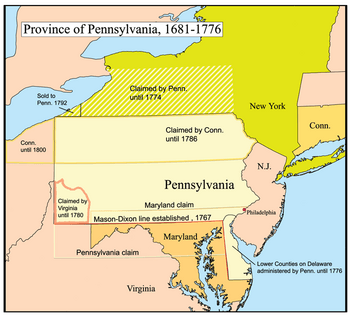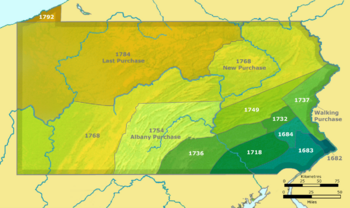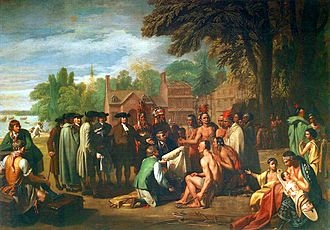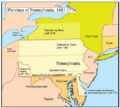Province of Pennsylvania facts for kids
Quick facts for kids
Province of Pennsylvania
|
|||||||||||
|---|---|---|---|---|---|---|---|---|---|---|---|
| 1681–1776 | |||||||||||
|
|
|||||||||||

Map of the Province of Pennsylvania
|
|||||||||||

Land purchases from Native Americans in Pennsylvania
|
|||||||||||
| Status |
|
||||||||||
| Capital | Philadelphia | ||||||||||
| Official languages | English and Pennsylvania Dutch | ||||||||||
| Government | Proprietary Colony | ||||||||||
| Proprietor | |||||||||||
|
• 1681–1718
|
William Penn (first) | ||||||||||
|
• 1775-1776
|
John Penn (last) | ||||||||||
| Governor | |||||||||||
|
• 1681-1682
|
William Markham (first) | ||||||||||
|
• 1773-1776
|
John Penn (last) | ||||||||||
| Legislature | (1683-1776) Provincial Assembly (1776) Provincial Conference |
||||||||||
|
• Upper house
|
Provincial Council | ||||||||||
|
• Lower house
|
General Assembly | ||||||||||
| History | |||||||||||
|
• Land grant by Charles II of England to William Penn
|
March 4, 1681 | ||||||||||
| July 4, 1776 | |||||||||||
| Currency | Pennsylvania pound | ||||||||||
|
|||||||||||
| Today part of | United States | ||||||||||
The Province of Pennsylvania was an important British colony in North America. It was also known as the Pennsylvania Colony. William Penn founded it in 1681 after King Charles II gave him the land. The name "Pennsylvania" means "Penn's Woods," honoring William Penn's father, Admiral Sir William Penn.
This colony was special because it was a "proprietary colony." This means the Penn family owned and governed it. They kept control until the American Revolution. After the Revolution, Pennsylvania became one of the first thirteen states of the United States. The "lower counties on Delaware" were part of Pennsylvania but later became the separate state of Delaware.
Many different people came to live in Pennsylvania. These included English Quakers, Germans, and Scot-Irish settlers. The Lenape Native American tribe tried to live peacefully with the Quakers. However, after William Penn and Tamanend, a Lenape leader, passed away, conflicts eventually began.
Philadelphia, the capital city, grew into a major port and business center. It was a key place for new ideas and plans that led to the American Revolution. In the 1700s, Philadelphia was the second-largest city in the British Empire, right after London. After the Revolutionary War, Philadelphia was the capital of the United States until 1800.
Contents
Colony's Land and Counties
Even though King Charles II gave William Penn the land, Penn wanted to buy it fairly from the Native Americans. The Lenape tribe lived on much of the land near what is now Philadelphia. They expected payment to move from their territory.
Penn and his representatives made many agreements with the Lenape and other tribes. These agreements helped define the colony's borders.
Early Counties Established
The first agreements happened between 1682 and 1684. These covered areas between New Jersey and the former Delaware Colony. Pennsylvania was first divided into three main counties: Bucks County, Philadelphia County, and Chester County.
Lower Counties on Delaware Bay
The "lower counties on Delaware" were a separate part of the province. These three counties are the same ones that make up the state of Delaware today: New Castle, Sussex, and Kent. Their borders are still the same.
Expanding Westward: New Lands and Counties
Over several decades in the 1700s, more agreements were made with Native Americans. These treaties, signed in 1718, 1732, 1737, 1749, 1754, and 1754, pushed the colony's boundaries further north and west.
By the time the French and Indian War started in 1754, Pennsylvania had created more counties. These included Lancaster (1729), York (1749), Cumberland (1750), Berks (1752), and Northampton (1752).
After the French and Indian War, another treaty was signed in 1768. This treaty followed the rules of the Royal Proclamation of 1763. This proclamation set a temporary border to prevent settlers from moving onto Native American lands. This changed Penn's original land grant. Future land purchases would happen after Pennsylvania became an independent state. Before the American Revolutionary War, more counties were formed: Bedford (1771), Northumberland (1772), and Westmoreland (1773).
Religious Freedom and Growth
William Penn and his fellow Quakers strongly influenced Pennsylvania's early government. The Charter of Privileges allowed religious freedom for anyone who believed in one God. The government was open to all Christians.
Until the French and Indian War, Pennsylvania had no army, few taxes, and no public debt. This helped Philadelphia grow quickly into a very important city. The Pennsylvania Dutch Country also thrived. German (or "Deutsch") religious refugees found success there.
Many groups settled in Pennsylvania. The Mennonites founded Germantown in 1683. The Amish started the Northkill Amish Settlement in 1740. In 1751, two important institutions opened: Pennsylvania Hospital, the first hospital in the British colonies, and The Academy and College of Philadelphia, which later became the University of Pennsylvania. Benjamin Franklin helped start both of these, along with Philadelphia's first fire company in 1736. Also in 1751, the Liberty Bell was ordered for the Pennsylvania State House.
Relations with Native Americans
William Penn wanted fair dealings with Native Americans. This led to much better relationships with tribes like the Lenape and Susquehanna than in most other colonies. The Quakers treated Native Americans with respect. They bought land from them willingly. They even had Native Americans and white settlers serve on juries together.
The Treaty of Shackamaxon was very famous. The writer Voltaire said it was "the only treaty between Indians and Christians that was never sworn to and that was never broken." The Quakers also refused to help in New England's Indian wars.
The Walking Purchase
In 1737, the colony's good relationship with the Lenape changed. Colonial leaders claimed they had a deed from the 1680s. This deed supposedly said the Lenape-Delaware promised to sell land. The land stretched from the meeting point of the Delaware River and Lehigh River in Easton, Pennsylvania. It was to go "as far west as a man could walk in a day and a half."
This deal became known as the Walking Purchase. The document was likely fake, but the Lenape didn't know this. Provincial Secretary James Logan planned to get as much land as possible. He hired three fast runners to "walk" the purchase. They ran on a path that had been cleared beforehand. The pace was so fast that only one runner finished. He covered an amazing 70 miles (113 km).
This "walk" gave the Penn family 1.2 million acres (4,856 km²) of land. This area is in what is now northeastern Pennsylvania. It is roughly the size of the state of Rhode Island. The purchase covered all or part of Pike, Monroe, Carbon, Schuylkill, Northampton, Lehigh, and Bucks counties.
The Lenape tribe tried for 19 years to cancel the treaty, but they failed. They were forced to move to the Shamokin and Wyoming Valleys. These areas were already crowded with other displaced tribes.
Limits on Further Settlement
As the colony grew, settlers and British soldiers clashed with Native Americans in western Pennsylvania. Britain fought France for control of the nearby Ohio Country during the French and Indian War. Britain won, and the territory became part of the British Empire in 1763.
After the French and Indian War and during Pontiac's War, the Royal Proclamation of 1763 was issued. This rule stopped colonists from settling beyond the Appalachian Mountains. It aimed to prevent conflicts over Native American lands. This proclamation affected Pennsylvanians and Virginians the most. Both groups had been moving towards the lands around Fort Pitt (now Pittsburgh).
Important People from Colonial Pennsylvania
Many famous people lived in or came from colonial Pennsylvania.
- John Dickinson was one of the Founding Fathers of the United States.
- Benjamin Franklin moved to Philadelphia at age 17 in 1723. He became Pennsylvania's most famous citizen. He founded the Academy and College of Philadelphia (later the University of Pennsylvania) in 1751. Franklin also pushed for a state militia.
- Thomas McKean was born in New London, Pennsylvania. He was an officer in the Continental Army during the American Revolution. He signed the Declaration of Independence. He also served as President of the U.S. Congress and Governor of Pennsylvania.
- Gouverneur Morris, a key thinker of the American Revolution, moved to Philadelphia to work as a lawyer.
- Robert Morris moved to Philadelphia around age 14. He was known as the "Financier of the Revolution" because he helped get money for the American side during the war. Robert Morris University is named after him.
- John Morton was born in Ridley Township, Pennsylvania. He was a delegate to the Continental Congress and signed the United States Declaration of Independence.
- Timothy Murphy was a skilled marksman in the Continental Army.
- Abraham op den Graeff was a founder of Germantown, Philadelphia. He was also a member of the Pennsylvania Provincial Assembly. He signed the first organized religious protest against slavery in colonial America.
- Thomas Paine moved to Philadelphia in 1774. His famous writing, Common Sense, published in 1776, strongly argued for the American Revolution. He was also the first to publicly use the phrase "United States of America."
- William Penn was the founder of the colony.
- George Ross moved to Philadelphia to practice law. He was a delegate to the Continental Congress and signed the United States Declaration of Independence.
- Peggy Shippen was the daughter of a well-known Philadelphia merchant. She was the wife of Benedict Arnold.
- Arthur St. Clair moved to Ligonier Valley, Pennsylvania in 1764. He was a judge, a general in the Continental Army, and a President under the Articles of Confederation.
- Samuel Van Leer was an ironmaster and captain in the American Revolutionary War.
- Anthony Wayne was a general in the American Revolutionary War.
- James Wilson moved to Philadelphia in 1765 and became a lawyer. He signed the United States Declaration of Independence. He also helped write many important parts of the U.S. Constitution.
Images for kids
See also
 In Spanish: Provincia de Pensilvania para niños
In Spanish: Provincia de Pensilvania para niños






